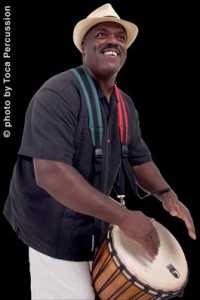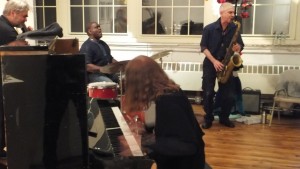 Part 1: Michael Wimberly (Part One of a Two Part Feature) – A Congress of Masters, Evolving Music Begins with a Notable Performance.
Part 1: Michael Wimberly (Part One of a Two Part Feature) – A Congress of Masters, Evolving Music Begins with a Notable Performance.
Date: January 13, 2014
Venue: Clemente Soto Velez Center (NY)
Text by Dawoud Kringle
Michael Wimberly‘s stint as curator for Arts for Art Evolving Music Series continued with a presentation of African music and jazz.
The evening’s music began with Wimberly playing djembe, Yakouba Sissoko from Mali on kora and Famoro Dioubate from Guinea on balafon. Wimberly explained that his role would be that of observer/improviser to the two masters.
The balafon began, and the kora responded. Soon the two were off on a song about separation of lovers. The two raced through an incredibly complex exploration. Wimberly joined them, and rode the multi layered rhythms and phrases the two played.
They continued with a song in a minor key. It had a sad mood to it; yet was never slow or laconic. Throughout, the two brought out of what is actually very simple harmony the most amazing complexity and variety of rhythms, phrases, polyrhythms, implied phrases, melodies within melodies, counterpoints, and an overall lyrical beauty.
The third piece had Wimberly playing trap drums. His efforts to wed African to jazz produced an interesting result. He used many of the same rhythmic devices he’d used on djembe – the nature of what Sissoko and Dioubate played demanded it. But what was startling and different were the textures one usually associates with jazz being used in this context. Yet it worked very well; and the two desperate worlds easily found a common ground to work from.
At this point, Wimberly asked what would be done if they’d invited a griot into their home to commemorate some one’s passing/a clear reference to the recent passing of Roy Campbell and Amiri Baraka. Sissoko spoke about the underlying unity of all people. Then Sissoko sang a beautiful song about the transitory nature if life; and how it’s important to make your mark and enjoy life, because death can take you, but it can never take your name.
After Sissoko shared some history of the Mandingo Empire, Wimberly brought Avram Fefer on bass clarinet and Missia Dioubate on vocals to join them. This would be a deviation from the tradition, and an exploration of mixed cultures. Dioubate began a light hearted dance on balafon and was joined by Wimberly, Sissoko and Fefer. Missia sang beautifully; her powerful feminine voice soaring over the swaying dance if the instruments.
The next set was a quartet featuring Wimberly on drums, Ken Filiano on bass, Connie Crothers on piano, and Louis Belogenis on saxophone. The performance was dedicated to Borah Bergman, and to Roy Campbell.
Shimmering cymbals, lurking notes from the bass, and fractal edgy chords on piano ushered in the improvisation. The sax weaved in and out with bluesy mournful calls. Wimberly soon brought in a bebop-ish propelling in the ride cymbal that briefly took the band into a jazz excursion. This dissolved into a duet between the piano and bass. The piano took the lead, and while the bass made use of electronic delays to create drones, the piano wove thick textures in and around itself. It rose to a climax, and the soprano sax broke through with its own testimony. Finally it all faded to oblivion. From out of a moment of silence, the piano rose up with polychords and startling harmonics. The band responded with a liquid flow in and around the sharp crystal edges the piano produced. They asserted their mastery over the chaos and ended on a dime. (During the set, Crothers broke a key on the piano; the Eb above middle C was martyred.)
They continued with an edgy dance of punches and counterpunches with the bass taking the lead. The sax took over the lead. Wimberly once again moved the group to a rude cymbal bebop drive. This time it didn’t dissipate as it had before. They explored this for a while. This morphed into another fistfight between the drums, bass, and piano, and then a truce was called. The sax took the lead, with the piano and bass playing a strange minimalist background. This faded to some quiet shimmering chords and stones, with the sax doing an almost Pharoah Saunders blues. Thus it ended.
The next song began with the bass playing a walking line augmented with delay. The drums and piano provided counterparts, with the piano adding delightfully exotic chord melodies. After a while the sax had his say, the bass, drums, and piano responding with fractal inversions. A climax was reached which eased into a free blues. The bass took the lead with dignified major key melodies. The piano’s accompaniment/commentary drew thus into atonalism, and the bass fought against the current, returning to the major key. It faded, and the piano began an exploration in F around the lower registers.
Suddenly, the music went into a different direction; a sad, and almost frightened sound. They spent a great deal of time in this realm. Finally, it reached a fevered pitch and howled its agony and ecstasy. After riding the wave, a blues grew out of the ashes of this fire. The blues disassembled and reassembled itself and twisted itself into an abrupt end.
Thus, a marvellous performance was ended.
Arts for Art are valiantly striving to present improvised music, and in doing so, keep it alive. And a job well done!



